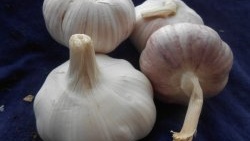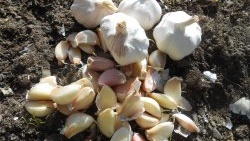The long-known truth that there are no trifles in the cultivation of root crops has not lost its relevance to this day. Summer residents who grow garlic on their plots know that it is not enough to collect a bountiful harvest of juicy marketable bulbs. To enjoy your own harvest of spicy onion vegetables, you need to properly prepare it for long-term storage and create ideal storage conditions.
Signs of ripening winter garlic
Winter varieties of garlic planted at the end of the previous season ripen in July. A sign that the bulbs are ready for harvesting is massive yellowing and lodging of the tops. First, only the lower leaves dry out, and then they lose their plastic substances and the upper feathers.
With their appearance, bolting varieties of garlic always signal to gardeners that the growing season has ended. The time to dig up the food comes when the shell on the spherical inflorescence with bulbous bulbs begins to crack and the seeds fall out. By the way, shooters throw away only winter types of garlic.
Signs of ripening spring garlic
Spring varieties of garlic, planted in early spring, ripen in late summer - early autumn. The timing of harvesting spring garlic depends on the early maturity of each specific variety. As in the case of winter crops, the main sign of readiness for digging is the lodging of the tops.
And since you shouldn’t delay harvesting garlic, since the bulbs overexposed in the soil begin to crack and disintegrate into individual cloves, you should closely monitor the ripening of the onion vegetable, periodically digging up individual specimens for visual inspection of the heads. A fully ripe bulb has the outer shell color characteristic of this variety, a dense outer husk, and clearly visible teeth.
Rules for harvesting and drying garlic
It is recommended to dig up the garlic with a pitchfork along with the tops, and then lay it out on the surface of the beds to dry in the open sun throughout the day. Naturally, you can leave the harvest outdoors only in sunny weather. The next day, the plants are moved under a canopy for complete drying.
If it rains or the weather is cloudy in your region, then the garlic bushes are immediately transferred either under a shed, or to a barn, or to the attic. Drying the crop, spread out on burlap or sheets of cardboard in one layer, should take at least three weeks. And only after the above-ground part becomes dry, the stems and roots are cut off.
During the event, it is advisable to carefully clean the surface of the bulbs and root bed from adhering pieces of earth and grains of sand, as well as remove loose covering scales. Clean bulbs are less vulnerable to mechanical damage during transportation.
It is most convenient to store garlic in bunches.For this type of saving, the stems on the heads must be at least 20 cm. It is convenient to collect them by calibrating the heads to size, and then tie them with fabric ribbons or twine. Each such bunch contains from 10 to 20 bulbs, depending on the size.
Garlic bunches can be hung from the ceiling in any utility room with good ventilation. At room temperature, garlic remains fresh until mid-winter. If the bunches are taken to the cellar, where the air temperature is close to 0°C, then you can save the harvest until the next season.
For summer residents who plan to preserve garlic in a cold way (temperature from 0 to +2°C, air humidity 75-80%, high-quality ventilation system), for example, in an underground or cellar, the stems on the head are cut off completely, leaving stumps up to 2 cm Bulbs are stored in wooden, cardboard or plastic mesh boxes with holes for ventilation.
Before storing in the vegetable storehouse, the garlic is calibrated and reviewed again. Any mechanical damage and visual defects on the bulbs are a signal that it is better to set aside this specimen for use for culinary purposes in the coming weeks. Bulbs with cracked outer husks cannot be stored for long periods of time.
Seed garlic, which will be used for planting, is set aside separately. Spring garlic will be stored until early spring. Winter crop varieties will be planted in the garden this fall (September - early November). Only the best commercial bulbs with all varietal characteristics, large and healthy, are selected for planting material.
Collect and store garlic correctly!




















